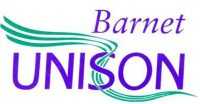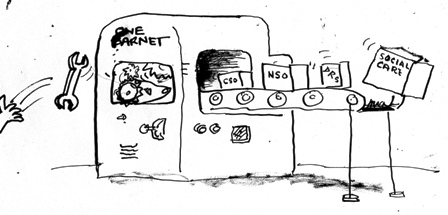Author: admin
Next Proposed One Barnet strike Action – Thursday 9 February
UNISON respond to transfer of council workers to The Barnet Group Ltd Local Authority Trading Company: Privatising Adults and Housing Services
To view our full report click here
Questions to the Cabinet Resources Committee on the Local Authority Trading Company: Privatising Adults and Housing Services.
1) If the LATC fails to make the profits outlined but makes losses instead will the Council bring the services back in-house?
2) The council wholly owns the LATC. What is the logic of extracting a “profit” from payments it makes and which now incur tax liabilities?
3) How does the drive for the LATC deriving profits from Direct Payments influence the level at which Direct Payments are set?
4) P.25 6.32 “The LATC should charge full market value for the goods or services it provides to the Council given that its tax liability will be based on the market value for such goods/ services.” What effect could this have on the level of Direct Payments issued to service users?
5) In the table 3 p.23 6.15 many of the amounts remain constant over the period of 4 years – is this realistic?
6) If surpluses are liable to Corporation Tax, why is this not reflected in the table?
7) At p.43 2.4 shouldn’t the cumulative figure in the table for year 3 and year 4 be a loss and not a profit? If no, why not?
8) P.64 7.1 Why does this not reflect the profit after tax?
9) Where does the figure of £49 million come from for the BarnetGroup Ltd p.32
9.18 and why is this not reflected in the table p.64 at 7.1 for the Barnet Group?
10) P.16 4.3 “The BarnetGroup Ltd could offset any corporation tax liability with additional trading activities” – what are the additional trading activities?
11) Which services are at risk of coming under a decision to close by April 2013 if they are not viable (p.51 table under 3.17.4)?
12) In the table listing risks p.50-51 there are no strategic risks lists, such as market penetration – what is being done to come up with a list of such risks and
the planned mitigation?
13) Where is the cost reduction programme referred to in the box against “Your Choice” (p.51 table)?
14) P.67 table at 1.1.5 identifies clients with no SWIFT ID – what are the business risks resulting from this?
15) From where will the group and its subsidiaries obtain working capital and where is the cost of this working capital?
Governance and TUPE
16) p.52 3.19.5 makes mention of a Barnet Group Procurement Officer. Who employs this person if BarnetGroup Ltd has no employees?
17) Who is the employer the Chief Executive Tracey Lees?
18) Remuneration has become a national issue therefore, what is the Governance arrangement for determining the remuneration of the Chief Executive and Directors?
Consultation
19) There is mention of unit costs in day services equating to one half day rather than one day. What are the plans for consultation with service users and their
carers with respect to this?
20) There is mention of moving to opening 7 days/ week and extending the opening times. What are the plans for consultation with staff, service users and carers with respect to this?
UNISON response to Proposed Transfer of the Housing Service to Barnet Homes and the Barnet Group
Barnet UNISON Questions to Cabinet Resources Committee on the Proposed Transfer of the Housing Service to Barnet Homes and the Barnet Group
1. Given that Barnet Homes already manage the void process closely with HNR, please provide evidence to support the assumption that performance will markedly improve following the merge?
2. There has recently been a significant increase in demand for homelessness services and there is an expectation that this will be sustained following the welfare reforms. How does the Council expect to manage this whilst at the same time making reductions in frontline staffing?
3. The 2012/13 400k savings required means that if Housing staff are transferred into Barnet Homes, the 60/40 split between General fund and HRA means that 10 posts will need to be cut to meet a required savings of 6 posts. In other words, if housing staff are transferred into Barnet Homes, a greater number of job cuts will be required to achieve the same degree of savings. How will this loss of posts lead to an improved customer experience?
4. What measures are in place to manage a fair and equitable process of implementing the staff cuts across LBB and Barnet Homes?
5. In considering the potential savings via posts [Table 2 in the report to Cabinet Resources Committee and 6.12 in the document going to General Functions], the cost of funding the posts of the Head of Service and the Accommodation and Resources staff appears to have been lumped together. If so, please explain why and provide a breakdown of the costs and expected savings.
6. Both Barnet Homes and Housing Needs and Resources should know how many vacancies they have. Please provide details of just how much of the savings can be realistically made via these vacancies.
To view full details of our report to Cabinet Resources Committee click here
UPDATE on UNISON response to Parking being outsourced to NSL
urgent update
Yesterday all the contractors were formally told who had won the contraxct.
The Council is now in what is known as the Alacatel period
When does the Standstill Period commence?
The period kicks in from the date the authority decides to award the contract. Usually this will come towards the end of an often lengthy procurement process where bidders will have been shortlisted and finally whittled down to one, for example through a process called “competitive dialogue”. At that point, when the authority makes its selection, the Alcatel Letter is issued and the standstill period should then commence. At the end of that period the contract is signed.
How long is the Standstill Period?
10 to 15 days from the decision to award, depending on the method by which the Alcatel letter is communicated. This is designed to give unsuccessful bidders an opportunity to challenge the award if they believe there has been a breach of the procurement rules.
Who should be sent an Alcatel letter?
Both the successful and unsuccessful “tenderers” and “candidates” in a procurement.. In other words, not only unsuccessful bidders but also any applicant who submitted a “PQQ” (a completed prequalification questionnaire) should receive one.

To view our report click here
Speed outsourcing One Barnet style
Speed dating speed outsourcing
UNISON response to outsourcing of Regulatory Services
UNISON respond to Parking being outsourced to NSL
To view report click here
UNISON response to AUDIT Committee
Dear Members of the Audit Committee
Please find enclosed UNISON’s response here to Agenda Item 10: Procurement Controls and Monitoring Plan Progress Report
Agenda Item 10 is a key report which no doubt you will give due attention and regard. I have been a regular attendee of Audit Committee and feel confident you will welcome our comments and questions.
The Council has made a political decision to become a Commissioning Council whereby it no longer provides services yet still wants to be able to ensure the provision of excellent services, alongside effective governance and strong performance.
For any organisation, public or private to make such far reaching transformation it must seek assurance that it has sufficient control over spend and procurement.
This UNISON report to the Audit Committee is our attempt to publicly identify the risks and our concerns about the above report and furthermore highlight the bigger concern that the Council is not fit and ready for such a massive transformation to become a ‘Commissioning Council’.
If you have any questions or concerns about the content of this report please do not hesistate to contact me.
Best wishes
John Burgess
Branch Secretary.
Barnet UNISON
0208 359 2088
Barnet UNISON “Watch it & Share it”
Defend Our Pensions




